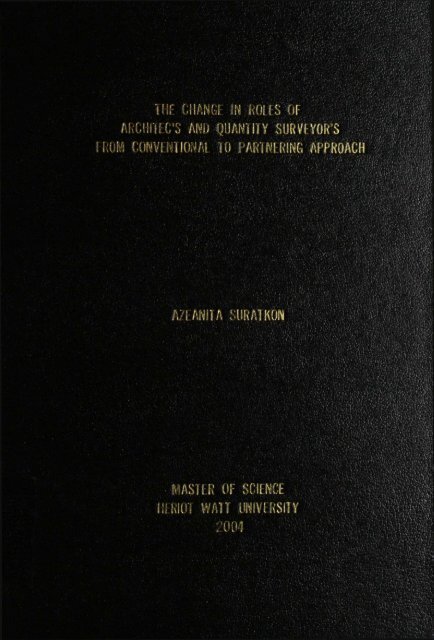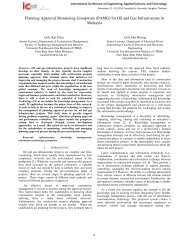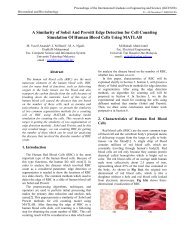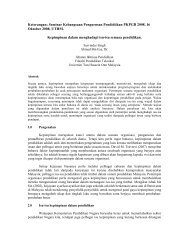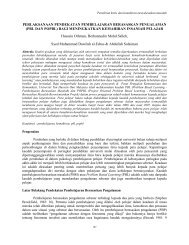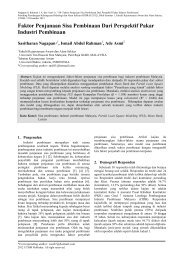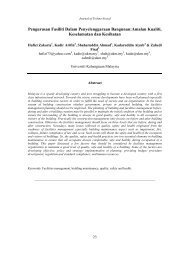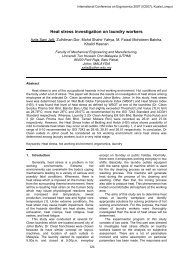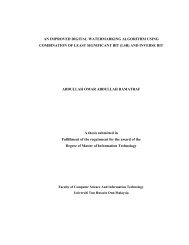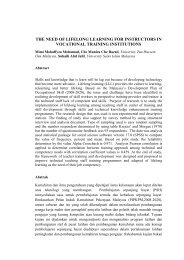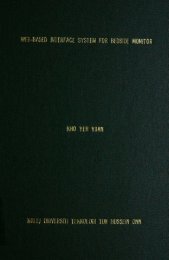the change in roles of architects and quantity surveyor's from ...
the change in roles of architects and quantity surveyor's from ...
the change in roles of architects and quantity surveyor's from ...
You also want an ePaper? Increase the reach of your titles
YUMPU automatically turns print PDFs into web optimized ePapers that Google loves.
Ai^j QHAN1HY SURVEYOR'S :<br />
!(jf^ (:(!NV!!:'U(!;^V! 10 PA}{'i)\'H(!^G APPROACH
THE CHANGE IN ROLES OF<br />
ARCHITECTS AND QUANTITY SURVEYOR'S<br />
FROM CONVENTIONAL TO PARTNERING<br />
APPROACH<br />
AZEANITA SURATKON<br />
Master <strong>of</strong> Science <strong>in</strong> Construction Management<br />
(Project Management)<br />
Schoo! <strong>of</strong> <strong>the</strong> Built Environment<br />
Heriot-Watt University<br />
2004
THE CHANGE IN ROLES OF<br />
ARCHITECTS AND QUANTITY SURVEYOR'S<br />
FROM CONVENTIONAL TO PARTNERING APPROACH<br />
Azeanita Suratkon<br />
(Reg. No.: 030681745)<br />
A dissertation submitted <strong>in</strong> partial fuifiiment <strong>of</strong> <strong>the</strong> requirements for <strong>the</strong> degree <strong>of</strong><br />
Master <strong>of</strong> Science <strong>in</strong> Construction Management<br />
(Project Management)<br />
Dissertation supervisor: Dr. Graeme Bowles<br />
Heriot-Watt University<br />
School <strong>of</strong> <strong>the</strong> Buiit Environment<br />
September 2004
DECLARATION<br />
I Azeanita Suratkon confirm that this work submitted for assessment is my own<br />
<strong>and</strong> expressed <strong>in</strong> my own words. Any use made with<strong>in</strong> it <strong>of</strong> works <strong>of</strong> o<strong>the</strong>r<br />
authors <strong>in</strong> any form (e.g. ideas, figures, text, tabies) are properiy acknowledged at<br />
<strong>the</strong>ir po<strong>in</strong>t <strong>of</strong> use. A iist <strong>of</strong> <strong>the</strong> references employed is <strong>in</strong>cluded.<br />
Signed<br />
Date
ACKNOWLEDGEMENTS<br />
I would like to thank a number <strong>of</strong> people for <strong>the</strong>ir assistance <strong>in</strong> help<strong>in</strong>g me to complete this<br />
dream. I express my s<strong>in</strong>cere thanks to Dr. Graeme Bowles who played an important role as<br />
my supervisor throughout my research process, provide guidance, encouragement <strong>and</strong><br />
assistance throughout <strong>the</strong> preparation <strong>and</strong> compilation <strong>of</strong> this dissertation.<br />
I must make very special thanks to my sister Al<strong>in</strong>a for <strong>the</strong> love, support <strong>and</strong> motivation that<br />
she provided me dur<strong>in</strong>g this research undertaken. I am very grateful to Nur Emma, who<br />
always had her doors open to me, to provide me guidance <strong>and</strong> assistance <strong>in</strong> my research.<br />
From <strong>the</strong> depth <strong>of</strong> my heart, I thank my parents who had provided underst<strong>and</strong><strong>in</strong>g, patience<br />
<strong>and</strong> support more than <strong>the</strong>y should. My s<strong>in</strong>cere thanks to my family for encourag<strong>in</strong>g me<br />
throughout my life.<br />
1 would also like to thank those respondents who took time out <strong>from</strong> <strong>the</strong>ir busy schedules to<br />
complete <strong>the</strong> questionnaire.<br />
F<strong>in</strong>ally, I would like to thank to KUiTTHO 'Koiej Universiti Teknologi Tun Husse<strong>in</strong> Onn'<br />
- Malaysia to trust me <strong>in</strong> my capacities <strong>and</strong> support me economically.<br />
i
ABSTRACT<br />
Architects <strong>and</strong> <strong>quantity</strong> surveyors are among <strong>the</strong> pr<strong>in</strong>cipal stakeholder us<strong>in</strong>g partner<strong>in</strong>g.<br />
Partner<strong>in</strong>g is <strong>in</strong>tended to improve <strong>the</strong> way projects are designed <strong>and</strong> constructed.<br />
Consequently, partner<strong>in</strong>g has an impact on <strong>the</strong> design <strong>and</strong> construction process. This<br />
research project aims to <strong>in</strong>vestigate how <strong>the</strong> various aspects <strong>of</strong> an architect's <strong>and</strong><br />
<strong>quantity</strong> <strong>surveyor's</strong> job have <strong>change</strong>d when compar<strong>in</strong>g conventional projects with those<br />
<strong>in</strong>volv<strong>in</strong>g a partner<strong>in</strong>g agreement. This study <strong>in</strong>tends to identify <strong>the</strong> practical impact <strong>of</strong><br />
partner<strong>in</strong>g on <strong>the</strong> architect's <strong>and</strong> <strong>quantity</strong> <strong>surveyor's</strong> role <strong>in</strong> <strong>the</strong> construction process <strong>and</strong><br />
ascerta<strong>in</strong> <strong>the</strong> strategy undertaken by <strong>the</strong> architect <strong>and</strong> <strong>quantity</strong> surveyor to adapt to<br />
partner<strong>in</strong>g.<br />
The means <strong>of</strong> data collection used was a postai questionnaire distributed to <strong>architects</strong><br />
<strong>and</strong> <strong>quantity</strong> surveyors with partner<strong>in</strong>g experience. Two separate sets <strong>of</strong> questionnaires<br />
were produced for each category <strong>of</strong> respondent <strong>and</strong> were designed to allow comparisons<br />
to be drawn between <strong>the</strong> architect <strong>and</strong> <strong>quantity</strong> surveyor.<br />
Based on <strong>the</strong> literature review, partner<strong>in</strong>g benefits <strong>and</strong> impacts were grouped <strong>in</strong>to seven<br />
head<strong>in</strong>gs. The results obta<strong>in</strong>ed, do not support <strong>the</strong> hypo<strong>the</strong>ses that partner<strong>in</strong>g has a great<br />
impact on <strong>the</strong>ir rotes <strong>and</strong> practices. They perceived that <strong>the</strong> highest severities <strong>of</strong> impacts<br />
are at major scale: procurement <strong>and</strong> contract issue for <strong>the</strong> <strong>architects</strong>, <strong>in</strong>formation<br />
ex<strong>change</strong> <strong>and</strong> dispute avoidance <strong>and</strong> resolution issues for <strong>the</strong> <strong>quantity</strong> surveyor. The<br />
survey revealed that an architect's role as a designer is <strong>the</strong> most frequently adopted <strong>in</strong> a<br />
partner<strong>in</strong>g approach compared to lead consultant <strong>and</strong> contract adm<strong>in</strong>istrator <strong>in</strong> a<br />
conventional approach, whereas, a <strong>quantity</strong> <strong>surveyor's</strong> role as a cost adviser rema<strong>in</strong>s<br />
dom<strong>in</strong>ant. These do not support <strong>the</strong> hypo<strong>the</strong>ses that <strong>the</strong>ir <strong>roles</strong> adopted <strong>in</strong> a conventional<br />
approach will <strong>change</strong> radically <strong>in</strong> a partner<strong>in</strong>g approach. The hypo<strong>the</strong>ses that a <strong>quantity</strong><br />
surveyor is more flexible than an architect <strong>in</strong> adapt<strong>in</strong>g to <strong>change</strong> imposed by a<br />
partner<strong>in</strong>g approach are also not supported by <strong>the</strong> results.<br />
The results do suggest that an architect has a preference to develop a close relationship<br />
with design-build contractors, while <strong>quantity</strong> surveyors prefer to market <strong>the</strong>mselves to<br />
clients who can potentially <strong>in</strong>itiate partner<strong>in</strong>g arrangements as a strategy to adapt <strong>in</strong> a<br />
competitive partner<strong>in</strong>g market. The role as an <strong>in</strong>dependent client adviser <strong>and</strong> project<br />
manager are <strong>the</strong> two <strong>roles</strong> discovered by <strong>the</strong> survey as potentially <strong>the</strong> most suitable<br />
potential to <strong>architects</strong> <strong>and</strong> <strong>quantity</strong> surveyors to take on as alternative <strong>roles</strong> <strong>in</strong> a<br />
partner<strong>in</strong>g era.<br />
ii
LIST OF CONTENTS<br />
ACKNOWLEDGEMENTS<br />
ABSTRACT<br />
LIST OF CONTENTS<br />
LIST OF TABLES AND FIGURES<br />
ABBREVIATIONS<br />
i<br />
ii<br />
iii<br />
vi<br />
viii<br />
CHAPTER 1 - INTRODUCTION 1<br />
1.1. Po<strong>in</strong>t <strong>of</strong> departure <strong>and</strong> research issue 1<br />
1.2. Aim <strong>of</strong> Research 4<br />
1.3. Objectives <strong>of</strong> Research 4<br />
1.4. Hypo<strong>the</strong>ses 4<br />
1.5. Scope <strong>of</strong> Research 5<br />
1.6. Dissertation Structure 5<br />
7. 6*. 7 /H/waKcf/on J<br />
7.6.2 Z.;;era;Mre revfew 3<br />
7.6.3 Payearc/*! Me^oao/ogy 6<br />
7.6.4 ^Ma/y.H.y <strong>of</strong> /Fe F.afM/7.r 6<br />
7.6. J Aweary a7;a* Co??c/M.HOM <strong>of</strong> 7/?e Reyearc/: Df-Mer/a?^? 6<br />
1.7. Conclusion 6<br />
CHAPTER 2 - ARCHITECT AND QUANTITY SURVEYORS IN THE PROJECT<br />
LIFE CYCLE 7<br />
2.1 The Concept <strong>of</strong> Consultant <strong>and</strong> Role 7<br />
2.7. / CoHSM/raH? De/?n;r;'on 7<br />
2.7.2 Co7!.YM/7a7icy pMrpo^ey #<br />
2.7. J Co7MfrMc?;'c7; conyM/7an/j #<br />
2.7.
2.4.2 Con7rac/Ma//'%Wyer 29<br />
2.4. J ProcMrewent 5pec;a/;'yf 29<br />
2.4.4 Lea^ ConyM/fan? 29<br />
2.5 Traditional Approach 30<br />
2.3.7 C7:arac;e7*;'yf;'c q/* Tra^'rz'oKa/ y4pp/*oac7! 3 i<br />
2.3.2 DrawoacAy <strong>of</strong>co77ve/7/707!a7 co7:yf7*Mcf707! p7*oceyy 32<br />
2.6 Conciusion 34<br />
CHAPTER 3 - ROLES AND PRACTICES OF ARCHITECT AND QUANTITY<br />
SURVEYOR IN PARTNERING APPROACH 35<br />
3.1 Partner<strong>in</strong>g Def<strong>in</strong>ition 35<br />
3.2 Construction Partner<strong>in</strong>g Process 36<br />
3.3 Integrated process <strong>and</strong> teams 38<br />
3. J. 7 Tnfegraf e^prp/'ec/ process 3P<br />
3.3.2 THfegra/ea*prq/'ec? 7eaw 40<br />
3.4 Partner<strong>in</strong>g Impacts <strong>and</strong> Benefits 42<br />
3.4.7 ProcMrewe^t ana* Confrac/s 43<br />
3.4.2 Coy/ MHprovewe?;/ 43<br />
3.4.3 Dey/gn ana* coMyfn;c?aM;Ty 46<br />
3.4.4 Dz'ypM/e a wMa/ice a7:a* reyo/Mfr'oH 4P<br />
3.4.3 77!/br/7!a7;'o7: exc/:a7:ge 4P<br />
3.4.6 rrbrAr/oaa*. 37<br />
3.4.7 Leaaery/Hp 32<br />
3.5 Perspective towards Partner<strong>in</strong>g 53<br />
3.6 Strategy to adapt to partner<strong>in</strong>g 55<br />
3.6.7 Par^erwg ana* caree?' proypecfy 33<br />
3.6.2 ^ffrac/7'or: ;o ^vo/vea* par/77er77:ga7-7a7:ge777e77/ 36<br />
3.6.3 &7-a/egy /o co/TzpeZe par77;e7*77:g qppor/MTzzYz'ey 36<br />
3.6.4 Po/eTz/r'a/Po/e ^<br />
3.7 Conciusion 60<br />
CHAPTER 4 - RESEARCH DESIGN AND METHODOLOGY 61<br />
4.1 Research Design 61<br />
4.2 Types <strong>of</strong> Research 62<br />
4.2.7 0Ma7!/;fa7z'vePesearc/: ^<br />
4.2.2 gMa/z/afz'veFeyearc/z ^<br />
4.3 Data Collection Approach 63<br />
4.3.7 Case -S/May ^pproac/z<br />
4.3.2 .Surveys ,4pp7-oac%<br />
4.4 Data Collection Techniques 65<br />
4.4.7 7nfe7*v:ew ^<br />
4.4.2 gMey/;07!7!a:re ^<br />
4.5 Selection <strong>of</strong> Methods <strong>and</strong> Techniques 67<br />
4.6 Sample <strong>and</strong> Response 68<br />
4.7 Design <strong>of</strong> <strong>the</strong> Postal Questionnaire 69<br />
4.8 Method <strong>of</strong> Data Analysis 70<br />
iv
4.9 Conclusion 70<br />
CHAPTER 5 - RESULT AND ANALYSIS 71<br />
5.1 The rate <strong>of</strong> response 71<br />
5.2 Section A: General Information 72<br />
-5.7.7 Vixpenence i'n constrMCt/on waHS/ry 72<br />
J. 7.2 Experience i'n partner<strong>in</strong>gprq/ect 7^<br />
5.3 Section B: The Impacts <strong>of</strong> <strong>the</strong> Partner<strong>in</strong>g on Architect/<br />
Quantity Surveyor's Roles <strong>and</strong> Practice 74<br />
3.7.3 Partner<strong>in</strong>g /wipac^ on ro/es ana*practices q/"arcn/tect ana* aMant/ty<br />
SMrveycr 74<br />
J. 7.4 77ie trend q/*arcA/tect's ana* aMant/ry SMrveyor's ro/e adopted i'n<br />
constrMCti'on prq/ect #7<br />
3.7.3 Tender <strong>and</strong> design #4<br />
3.7.6 7nvo7venient issues ;'n constrMcti'onprq/'ects #7<br />
5.4 Section C: The Strategy to Adapt <strong>in</strong> Partner<strong>in</strong>g Era 91<br />
3. V. 7 Attract/on to get i'nvo/ved t'n partner<strong>in</strong>g arrangement P7<br />
3.4.2 77ireatsyrom partner<strong>in</strong>g. P7<br />
3.4.3 Partner<strong>in</strong>g opportMHitt'es P3<br />
CHAPTER 6 - CONCLUSION 98<br />
6.1 Answers to research objectives 98<br />
6.2 Validity <strong>of</strong> <strong>the</strong> hypo<strong>the</strong>ses 101<br />
6.3 Limitation <strong>of</strong> <strong>the</strong> research 103<br />
6.4 Suggestion for future research 103<br />
REFERENCES 106<br />
APPENDIX 1/a - Research Questionnaire For Architect<br />
APPENDIX 1/b - Research Questionnaire For Quantity Surveyor<br />
APPENDIX 2 - Summary Of Analysis Results<br />
APPENDIX 3 - Caicuiation For Question 5<br />
v
LISTS OF TABLES<br />
Table<br />
Page<br />
Table 2.1: The competences <strong>of</strong> consultant 11<br />
Table 2.2: RIBA outl<strong>in</strong>e plan <strong>of</strong> work 13<br />
Table 2.3: Summary <strong>of</strong> Architect's <strong>and</strong> Quantity Surveyor's Responsibilities 16<br />
Table 2.4: Responsibilities <strong>of</strong> Independent Client Adviser (ICA)<br />
<strong>and</strong> Integrated Project Team (IPT) 21<br />
Table 2.5: Project management framework: objectives <strong>and</strong> activities 23<br />
Table 2.6: The role <strong>of</strong> architect 26<br />
Table 2.7: The role <strong>of</strong> <strong>quantity</strong> surveyor 28<br />
Table 4.1: Differences between Qualitative <strong>and</strong> Quantitative Method 63<br />
Table 4.2: Strengths <strong>and</strong> weaknesses <strong>of</strong> <strong>the</strong> research approach 64<br />
Table 4.3: Strengths <strong>and</strong> weaknesses <strong>of</strong> <strong>the</strong> data collection techniques 66<br />
Table 5.1: Questionnaire sent, received <strong>and</strong> valid responses 71<br />
Tabie 5.2: Roies <strong>of</strong> architect frequently adopted <strong>in</strong> a project us<strong>in</strong>g<br />
conventional <strong>and</strong> partner<strong>in</strong>g approach. 82<br />
Table 5.3: Roles <strong>of</strong> <strong>quantity</strong> surveyors frequently adopted <strong>in</strong> a project<br />
us<strong>in</strong>g conventional <strong>and</strong> partner<strong>in</strong>g approach. 83<br />
Table 5.4: Attraction to get <strong>in</strong>volved <strong>in</strong> partner<strong>in</strong>g arrangement 91<br />
Table 5.5: Strategy adopted to get partner<strong>in</strong>g project. 95<br />
Table 5.6: Potential role for <strong>architects</strong> <strong>and</strong> <strong>quantity</strong> surveyors embark on<br />
<strong>in</strong> partner<strong>in</strong>g era. 96<br />
vi
LIST OF FIGURES<br />
Figure<br />
Page<br />
Figure i: Partner<strong>in</strong>g <strong>in</strong> practice 2<br />
Figure 2.1: Category <strong>of</strong> consultants <strong>in</strong> construction project 9<br />
Figure 2.3: Framework for construction procurement 18<br />
Figure 2.4: The partner<strong>in</strong>g process 24<br />
Figure 2.5: Vicious circie <strong>in</strong> <strong>the</strong> construction procurement process 32<br />
Figure 3. i: The project partner<strong>in</strong>g process 37<br />
Figure 3.2: Partner<strong>in</strong>g process 38<br />
Figure 3.3: The Movement for Innovation's '5-4-7' model. 40<br />
Figure 3.4: Integrated Project Team 41<br />
Figure 5.1: Experience <strong>in</strong> construction <strong>in</strong>dustry 72<br />
Figure 5.2: Experience <strong>in</strong> partner<strong>in</strong>g 73<br />
Figure 5.3: Number <strong>of</strong> partner<strong>in</strong>g project undertaken 74<br />
Figure 5.4: Severity <strong>of</strong> partner<strong>in</strong>g impacts on roies <strong>and</strong> practices <strong>of</strong><br />
<strong>architects</strong> <strong>and</strong> <strong>quantity</strong> surveyors 78<br />
Figure 5.5: Frequency <strong>of</strong> negotiated tender used <strong>in</strong> partner<strong>in</strong>g project 84<br />
Figure 5.6: Views on partner<strong>in</strong>g shorten <strong>the</strong> design <strong>and</strong> tender period 85<br />
Figure 5.7: Workload <strong>in</strong> tender stage 86<br />
Figure 5.8: Workioad <strong>in</strong> tender stage 87<br />
Figure 5.9: Views <strong>of</strong> architect on supply cha<strong>in</strong> <strong>in</strong>volvement <strong>in</strong> design stage 88<br />
Figure 5.10: Views <strong>of</strong> <strong>quantity</strong> surveyor on supply cha<strong>in</strong> <strong>in</strong>volvement<br />
<strong>in</strong> design stage 88<br />
Figure 5.11: Potential to <strong>in</strong>crease <strong>in</strong>volvement <strong>in</strong> construction process<br />
by adopt<strong>in</strong>g partner<strong>in</strong>g 89<br />
Figure 5.12: Involvement <strong>in</strong> extra work 90<br />
Figure 5.13: Architect lose authority <strong>in</strong> decision mak<strong>in</strong>g 90<br />
Figure 5.14: Views on partner<strong>in</strong>g lead to reduce career prospects 92<br />
Figure 5.15: Competition between architect <strong>and</strong> contractor 92<br />
Figure 5.16: Decrease <strong>in</strong> traditional <strong>quantity</strong> survey<strong>in</strong>g activity 93<br />
Figure 5.17: Ignore partner<strong>in</strong>g opportunities 94<br />
vii
ABBREVIATIONS<br />
A4PM Architects for Project Management<br />
ACA Association <strong>of</strong> Consultant Architects (ACA)<br />
BDB Buiid<strong>in</strong>g own Barrier<br />
CIB<br />
Construction Industry Board<br />
CH<br />
Construction Industry Institute<br />
CIOB The Chartered Institute <strong>of</strong> Buiid<strong>in</strong>g<br />
CIRIA Construction Industry Research And Information Association<br />
DEO<br />
Defence Estate Organisation<br />
ICA<br />
Independent client Advisers<br />
IPT<br />
Integrated Project Team<br />
1ST<br />
Integrated Suppiy team<br />
MOD M<strong>in</strong>istry <strong>of</strong> Defence<br />
NAO National Office Audit<br />
NEDO National Economic Development Office<br />
OGC Office <strong>of</strong> Government Commerce<br />
PPC 2000 Project Partner<strong>in</strong>g Contract 2000<br />
PJBA The Royal Institution <strong>of</strong><br />
RICS The Royal Institution <strong>of</strong> Chartered Surveyors<br />
UK<br />
United K<strong>in</strong>gdom<br />
viii
C H A P T E R 1
Chapter 1<br />
CHAPTER 1<br />
INTRODUCTION<br />
1.1. Po<strong>in</strong>t <strong>of</strong> departure <strong>and</strong> research issue<br />
The construction <strong>in</strong>dustry is weii known for its fragmentation <strong>of</strong> construction processes<br />
<strong>and</strong> adversaria! contractual relationships, which may lead to set <strong>of</strong> problems <strong>and</strong><br />
disputes among different parties <strong>in</strong> a project. The emergence <strong>of</strong> partner<strong>in</strong>g is seen as a<br />
tool that can help elim<strong>in</strong>ate or reduce <strong>the</strong> implications <strong>of</strong> such problems. Therefore, <strong>the</strong><br />
<strong>in</strong>corporation <strong>of</strong> a partner<strong>in</strong>g approach <strong>in</strong> construction draws much attention <strong>from</strong><br />
<strong>the</strong>orists <strong>and</strong> practitioners <strong>of</strong> <strong>the</strong> construction <strong>in</strong>dustry.<br />
(a) Consultant <strong>in</strong> partner<strong>in</strong>g<br />
Partner<strong>in</strong>g is a structured management approach to facilitate team work<strong>in</strong>g across<br />
contractual boundaries (Construction Industry Board, 1997). Figure 1 illustrates <strong>the</strong><br />
ma<strong>in</strong> stakeholders <strong>in</strong> a project. Consultants are part <strong>of</strong> <strong>the</strong> partner<strong>in</strong>g stakeholders <strong>and</strong><br />
<strong>in</strong>teract with clients, lead contractors, suppliers <strong>and</strong> specialist contractors. Each <strong>of</strong> <strong>the</strong>se<br />
stakeholders have <strong>the</strong>ir own responsibility <strong>and</strong> obligations (contracts) towards o<strong>the</strong>r<br />
parties. All <strong>the</strong> parties play important <strong>roles</strong> <strong>in</strong> order to success a partner<strong>in</strong>g arrangement<br />
itself <strong>and</strong> <strong>the</strong> completion <strong>of</strong> <strong>the</strong> project as <strong>the</strong> f<strong>in</strong>al product. Consultants are one <strong>of</strong> <strong>the</strong><br />
key players <strong>in</strong> any construction project. It is <strong>in</strong>evitable that <strong>the</strong>y become <strong>in</strong>volved at<br />
each stage <strong>and</strong> play a major <strong>roles</strong> <strong>from</strong> <strong>the</strong> early stages i.e. client brief <strong>and</strong> especially <strong>in</strong><br />
feasibility studies <strong>and</strong> <strong>the</strong> design process towards <strong>the</strong> completion <strong>of</strong> projects.<br />
Partner<strong>in</strong>g is <strong>in</strong>tended to improve <strong>the</strong> way projects are designed <strong>and</strong> constructed.<br />
Through partner<strong>in</strong>g, roies <strong>of</strong> <strong>in</strong>dividual consultants should complement client <strong>roles</strong> <strong>in</strong><br />
mak<strong>in</strong>g an improvement (The Hous<strong>in</strong>g Forum Procurement Work<strong>in</strong>g Group, 2001).<br />
Partner<strong>in</strong>g requires an '<strong>in</strong>tegrated project team' (IPT) where consultants establish <strong>the</strong><br />
supply team toge<strong>the</strong>r with constructors <strong>and</strong> specialist suppliers <strong>and</strong> cooperate with <strong>the</strong><br />
client team, work<strong>in</strong>g toge<strong>the</strong>r <strong>in</strong> an <strong>in</strong>tegrated design <strong>and</strong> construction process. This is<br />
contrary to what <strong>the</strong>y used to practice <strong>in</strong> a conventional approach that is ma<strong>in</strong>ly<br />
characterised by a separation <strong>of</strong> <strong>the</strong> design <strong>and</strong> construction process.<br />
I
CHapfer I<br />
Figure 1: Partner<strong>in</strong>g <strong>in</strong> practice<br />
Source: "Partner<strong>in</strong>g <strong>in</strong> <strong>the</strong> Team", Construction Industry Board (1997).<br />
(b) Roie <strong>of</strong> consultants<br />
OGC (Office <strong>of</strong> Government Commerce, 2003) states that one <strong>of</strong> <strong>the</strong> success factors for<br />
overall project success is a ciear identification <strong>of</strong> <strong>roles</strong> <strong>and</strong> responsibilities for<br />
coord<strong>in</strong>at<strong>in</strong>g aspects <strong>of</strong> <strong>the</strong> design <strong>and</strong> construction processes. Especially for <strong>the</strong><br />
consultants who will get <strong>in</strong>volved <strong>in</strong> both processes <strong>the</strong>ir <strong>roles</strong> <strong>and</strong> responsibilities must<br />
be clearly identified. In addition, <strong>the</strong> identification <strong>of</strong> <strong>roles</strong> <strong>and</strong> responsibilities <strong>of</strong> <strong>the</strong><br />
project team <strong>in</strong> general has received a great deal <strong>of</strong> attention <strong>in</strong> partner<strong>in</strong>g workshops.<br />
For <strong>in</strong>stance, <strong>in</strong> <strong>the</strong> first partner<strong>in</strong>g workshop, one <strong>of</strong> <strong>the</strong> tasks <strong>of</strong> <strong>the</strong> facilitator is to<br />
check that all <strong>the</strong> essential team <strong>roles</strong> are likely to develop a teamwork (Peace <strong>and</strong><br />
Bennett, 2002) <strong>and</strong> partner<strong>in</strong>g workshops at design <strong>and</strong> pre-construction stages<br />
undertaken to <strong>in</strong>clude an agreement on <strong>roles</strong> <strong>and</strong> responsibilities <strong>and</strong> to def<strong>in</strong>e<br />
accountabilities (OGC, 2003). Therefore, it is vital to <strong>in</strong>vestigate <strong>the</strong> consultants' role<br />
s<strong>in</strong>ce <strong>the</strong>y are <strong>in</strong>volved directly <strong>in</strong> <strong>the</strong> whole lifecycle <strong>of</strong> a project.<br />
Hellard (1995) po<strong>in</strong>ts out one <strong>of</strong> <strong>the</strong> benefits <strong>of</strong> partner<strong>in</strong>g is enhanc<strong>in</strong>g <strong>the</strong> consultants'<br />
role <strong>in</strong> decision-mak<strong>in</strong>g <strong>and</strong> f<strong>in</strong>d<strong>in</strong>g solutions to problems at <strong>the</strong> conception <strong>and</strong> design<br />
phase. Therefore, it is useful to explore how <strong>the</strong> <strong>roles</strong> <strong>of</strong> consultants <strong>change</strong> <strong>from</strong> a<br />
traditional approach project to a partner<strong>in</strong>g approach project. In o<strong>the</strong>r words, <strong>the</strong>
C/Mpfer 1<br />
impacts <strong>of</strong> a partner<strong>in</strong>g approach on consultants' <strong>roles</strong>, practices or activities <strong>in</strong> a<br />
construction project should be identified.<br />
(c)<br />
Architect <strong>and</strong> <strong>quantity</strong> surveyor<br />
Architects <strong>and</strong> <strong>quantity</strong> surveyors are among <strong>the</strong> pr<strong>in</strong>ciple consultants us<strong>in</strong>g partner<strong>in</strong>g.<br />
Eriksen (1999) suggests feedback based on <strong>the</strong>ir h<strong>and</strong>s-on experiences participat<strong>in</strong>g <strong>in</strong> a<br />
project partner<strong>in</strong>g relationship is valuable <strong>and</strong> should be <strong>in</strong>cluded <strong>in</strong> <strong>the</strong> body <strong>of</strong><br />
knowledge about partner<strong>in</strong>g. To date <strong>the</strong>re has been little hard experience collected<br />
<strong>from</strong> <strong>the</strong>ir community. They may relate <strong>the</strong>ir partner<strong>in</strong>g experiences, compare results on<br />
projects that did <strong>and</strong> did not use partner<strong>in</strong>g, identify what worked well <strong>and</strong> what did not<br />
<strong>and</strong> suggest improvements that should be made to partner<strong>in</strong>g methods.<br />
The role <strong>of</strong> <strong>architects</strong> <strong>and</strong> <strong>quantity</strong> surveyors are undoubtedly vital <strong>in</strong> partner<strong>in</strong>g as<br />
highlighted <strong>in</strong> certa<strong>in</strong> authoritative publications <strong>and</strong> reports. The RUSA's (The Royal<br />
Institution <strong>of</strong> British Architects) own "Architects <strong>and</strong> <strong>the</strong> Chang<strong>in</strong>g Construction<br />
Industry" published <strong>in</strong> 2000 recognised "<strong>architects</strong> with <strong>the</strong>ir pivotal position <strong>in</strong> <strong>the</strong><br />
construction process, have a big contribution to make to <strong>the</strong> development <strong>of</strong><br />
partner<strong>in</strong>g." While, a target <strong>of</strong> 30% real cost reduction by <strong>the</strong> year 2000 suggested by<br />
<strong>the</strong> "Construct<strong>in</strong>g <strong>the</strong> team" report is an item <strong>of</strong> major importance to <strong>the</strong> <strong>quantity</strong><br />
survey<strong>in</strong>g pr<strong>of</strong>ession (Ashworth <strong>and</strong> Hogg, 2000). These are substantial evidences that<br />
both <strong>architects</strong> <strong>and</strong> <strong>quantity</strong> surveyors have a paramount role <strong>in</strong> mak<strong>in</strong>g partner<strong>in</strong>g a<br />
success.<br />
The success <strong>of</strong> partner<strong>in</strong>g lies heavily on <strong>the</strong> commitment <strong>of</strong> clients, contractors <strong>and</strong><br />
consultants, but most <strong>of</strong> <strong>the</strong> partner<strong>in</strong>g research are concern with <strong>the</strong> role that <strong>the</strong> clients<br />
<strong>and</strong> contractors play <strong>in</strong> partner<strong>in</strong>g success. Instead, consultants, <strong>in</strong>clud<strong>in</strong>g <strong>architects</strong>,<br />
eng<strong>in</strong>eers, surveyors, etc. are rarely mentioned (Cheung, et. al., 2003). This supports <strong>the</strong><br />
observation that <strong>the</strong>re is a severe lack <strong>of</strong> partner<strong>in</strong>g research focus on consultants<br />
especially <strong>architects</strong> <strong>and</strong> <strong>quantity</strong> surveyors even though <strong>the</strong>y are prom<strong>in</strong>ent <strong>in</strong> <strong>the</strong><br />
project team especially <strong>the</strong> design team. Normally, <strong>the</strong>se two pr<strong>of</strong>essionals will be first<br />
to be engaged by <strong>the</strong> client: <strong>the</strong> architect ma<strong>in</strong>ly to design <strong>the</strong> build<strong>in</strong>g <strong>and</strong> <strong>the</strong> <strong>quantity</strong><br />
surveyor ma<strong>in</strong>ly to cost <strong>the</strong> design. Thus, this research will revolve around <strong>the</strong>ir role <strong>and</strong><br />
practices <strong>in</strong> partner<strong>in</strong>g.<br />
3
oie adopted will <strong>change</strong> <strong>in</strong> partner<strong>in</strong>g compared with <strong>the</strong> conventional approach<br />
(non-partnered project).<br />
. Quantity surveyors are seen to be more flexible than <strong>architects</strong> <strong>in</strong> adapt<strong>in</strong>g to<br />
<strong>change</strong> imposed by a partner<strong>in</strong>g approach.<br />
1.5. Scope <strong>of</strong> Research<br />
This research will focus on <strong>architects</strong> <strong>and</strong> <strong>quantity</strong> surveyors <strong>in</strong> <strong>the</strong> UK construction<br />
<strong>in</strong>dustry only.<br />
This research will consider partner<strong>in</strong>g <strong>in</strong> general that may <strong>in</strong>clude or be applicable to<br />
both project partner<strong>in</strong>g <strong>and</strong> strategic partner<strong>in</strong>g.<br />
1.6. Dissertation Structure<br />
Z.d.J<br />
ZHfrodHcft'oH<br />
Chapter 1 discusses <strong>the</strong> po<strong>in</strong>t <strong>of</strong> departure <strong>and</strong> background <strong>of</strong> <strong>the</strong> research issues. These<br />
are <strong>in</strong>troduced to provide a broader underst<strong>and</strong><strong>in</strong>g <strong>of</strong> <strong>the</strong> issues <strong>and</strong> justify<strong>in</strong>g <strong>the</strong><br />
relevance <strong>of</strong> <strong>the</strong> research issue. Follow<strong>in</strong>g which <strong>the</strong> aims <strong>and</strong> objectives <strong>of</strong> <strong>the</strong> research<br />
are proposed. The scope <strong>of</strong> <strong>the</strong> research <strong>the</strong>n was narrowed to <strong>the</strong> areas' <strong>of</strong> study.<br />
Zf^afMrerewetf<br />
Chapter 2 describes <strong>the</strong> concept <strong>of</strong> consultant <strong>and</strong> <strong>the</strong>ir role, reviews three project<br />
iifecycle frameworks to identify <strong>roles</strong> <strong>and</strong> responsibilities <strong>of</strong> architect <strong>and</strong> <strong>quantity</strong><br />
surveyor <strong>and</strong> lastly addresses <strong>the</strong> characteristics <strong>and</strong> drawbacks <strong>of</strong> a traditional<br />
approach. This <strong>in</strong>formation is to provide an underst<strong>and</strong><strong>in</strong>g on <strong>the</strong> <strong>roles</strong> <strong>of</strong> <strong>architects</strong>' <strong>and</strong><br />
<strong>quantity</strong> surveyors' <strong>in</strong> <strong>the</strong> context <strong>of</strong> construction consultancy.<br />
Chapter 3 addresses <strong>the</strong> def<strong>in</strong>ition <strong>and</strong> process <strong>of</strong> partner<strong>in</strong>g, <strong>in</strong>tegrated process <strong>and</strong><br />
project team <strong>in</strong> a partner<strong>in</strong>g context. Then it highlights <strong>the</strong> impacts <strong>and</strong> benefits <strong>of</strong><br />
partner<strong>in</strong>g to roies <strong>and</strong> practices <strong>of</strong> <strong>architects</strong> <strong>and</strong> <strong>quantity</strong> surveyors, addresses how<br />
3
C/znpfer I<br />
consultants (represent<strong>in</strong>g architect <strong>and</strong> <strong>quantity</strong> surveyor) perceive partner<strong>in</strong>g <strong>and</strong><br />
possibie strategies to adapt <strong>in</strong> a partner<strong>in</strong>g era.<br />
7.6.J?<br />
7?eyearc/! ylfef/iogo/ogy<br />
Chapter 4 wiii look <strong>in</strong>to <strong>and</strong> evaiuate <strong>the</strong> different methodologies available for <strong>the</strong><br />
research to achieve its objectives, seiect <strong>the</strong> appropriate method <strong>of</strong> data coliection <strong>and</strong><br />
data anaiysis, <strong>and</strong> expla<strong>in</strong> <strong>the</strong> reason for this choice <strong>and</strong> how its reiates to <strong>the</strong> research<br />
objectives.<br />
7.6.4 y4na/J7Myo///;g7?esM?7s<br />
Chapter 5 wiii report <strong>the</strong> primary data coiiected, analyse <strong>and</strong> discuss <strong>the</strong> results <strong>of</strong> <strong>the</strong><br />
survey to determ<strong>in</strong>e whe<strong>the</strong>r <strong>the</strong> research objectives <strong>and</strong> hypo<strong>the</strong>ses are valid by<br />
reflect<strong>in</strong>g responses <strong>from</strong> <strong>the</strong> <strong>in</strong>dustry.<br />
7.6. J
C H A P T E R 2
C7:npfer 2<br />
CHAPTER 2<br />
ARCHITECT AND QUANTITY SURVEYOR<br />
IN THE PROJECT LIFE CYCLE<br />
The purpose <strong>of</strong> this chapter is to provide an underst<strong>and</strong><strong>in</strong>g <strong>of</strong> <strong>architects</strong>' <strong>and</strong> <strong>quantity</strong><br />
surveyors' <strong>roles</strong> <strong>in</strong> <strong>the</strong> context <strong>of</strong> construction consultancy <strong>and</strong> to highlight certa<strong>in</strong><br />
issues regard<strong>in</strong>g <strong>the</strong> traditional approach as a procurement route. This chapter beg<strong>in</strong>s<br />
with <strong>the</strong> concept <strong>of</strong> <strong>the</strong> consultant <strong>and</strong> <strong>the</strong>ir role, this will <strong>the</strong>n be followed by review<strong>in</strong>g<br />
three project lifecycle frameworks to identify <strong>the</strong> <strong>roles</strong> <strong>and</strong> responsibilities <strong>of</strong> both<br />
pr<strong>of</strong>essionals <strong>and</strong> <strong>the</strong>n to categorise <strong>the</strong>m. The characteristics <strong>and</strong> drawbacks <strong>of</strong> <strong>the</strong><br />
traditional approach will <strong>the</strong>n be <strong>in</strong>cluded to complete <strong>the</strong> chapter.<br />
2.1 The Concept <strong>of</strong> Consultant <strong>and</strong> Role<br />
Architects <strong>and</strong> <strong>quantity</strong> surveyors are pr<strong>of</strong>essional consultants who are prom<strong>in</strong>ent<br />
participants <strong>of</strong> a project consultant team. Therefore, before discuss<strong>in</strong>g <strong>the</strong>ir <strong>roles</strong> <strong>in</strong> <strong>the</strong><br />
project cycle, it is worthwhile to look at <strong>the</strong> general idea that revolves around <strong>the</strong><br />
concept <strong>of</strong>'consultant' <strong>and</strong> 'role'.<br />
2.7.7 Co/:sH^anrDe/?Hff/o/!<br />
Chambers' dictionary def<strong>in</strong>es a consultant as 'one who gives pr<strong>of</strong>essional advice', while<br />
Oxford d ictionary d ef<strong>in</strong>es i t a s ' person w ho i s p aid t o g ive e xpert a dvice'. F rom t he<br />
def<strong>in</strong>itions, <strong>the</strong> term 'pr<strong>of</strong>essional' <strong>and</strong> 'expert' are <strong>the</strong> ma<strong>in</strong> features <strong>of</strong> a consultant.<br />
Their pr<strong>of</strong>essionalism <strong>and</strong> expertise is recognised <strong>and</strong> expected <strong>in</strong> deliver<strong>in</strong>g <strong>the</strong>ir<br />
services. The Oxford def<strong>in</strong>ition expla<strong>in</strong>s that a certa<strong>in</strong> fee must be paid to a consultant<br />
for <strong>the</strong>ir expert advice. This also <strong>in</strong>dicates that normally <strong>the</strong>y are an <strong>in</strong>dependent<br />
organisation, outside <strong>of</strong> <strong>the</strong> client organisation <strong>and</strong> that <strong>the</strong>y are appo<strong>in</strong>ted to jo<strong>in</strong> <strong>the</strong><br />
client organisation <strong>in</strong> a specific project.<br />
7
Chapfer 2<br />
2.7.2 ConxM^ancy pmyoxes<br />
Turner (1982) as reported by Williams <strong>and</strong> Woodward (1994) produced a hierarchy <strong>of</strong><br />
purposes <strong>of</strong> consultancy <strong>in</strong> <strong>the</strong> area <strong>of</strong> management consult<strong>in</strong>g, which all are basically<br />
implemented <strong>in</strong> a construction project consultancy as well. These were:<br />
1. provid<strong>in</strong>g <strong>in</strong>formation to a client;<br />
2. provid<strong>in</strong>g a solution to a client's problem;<br />
3. mak<strong>in</strong>g a diagnosis, which may necessitate a redef<strong>in</strong>ition <strong>of</strong> <strong>the</strong> problem;<br />
4. mak<strong>in</strong>g recommendations based on <strong>the</strong> diagnosis;<br />
5. assist<strong>in</strong>g with <strong>the</strong> implementation <strong>of</strong> recommended solutions;<br />
6. build<strong>in</strong>g consensus <strong>and</strong> commitment around corrective actions;<br />
7. help<strong>in</strong>g clients learn how to resolve similar problems <strong>in</strong> <strong>the</strong> future;<br />
8. permanently improv<strong>in</strong>g organisational effectiveness.<br />
In a construction project, <strong>the</strong> ma<strong>in</strong> responsibility <strong>of</strong> a consultant team is to provide <strong>the</strong><br />
client with appropriate project <strong>in</strong>formation <strong>and</strong> an evaluation, recommendations <strong>and</strong><br />
solutions to problems that may arise. They also have a commitment to assist clients to<br />
implement all required polices, procedures, action <strong>and</strong> plann<strong>in</strong>g to ensure <strong>the</strong> success <strong>of</strong><br />
a project.<br />
2.7.3 Co/tsfrHCfM??: coMy^/ta/:ty<br />
Consultants <strong>in</strong> a construction project can be divided <strong>in</strong>to three ma<strong>in</strong> groups as<br />
categorised by <strong>the</strong> Office <strong>of</strong> Government Commerce, (OGC) (2003a) <strong>in</strong> its Procurement<br />
Guide 05.<br />
Designer or <strong>of</strong>ten referred to as design consuitants <strong>in</strong>clude <strong>architects</strong>, civil eng<strong>in</strong>eers,<br />
structural eng<strong>in</strong>eers, electrical eng<strong>in</strong>eers, mechanical eng<strong>in</strong>eers, public health eng<strong>in</strong>eers,<br />
urban designers, l<strong>and</strong>scape designers <strong>and</strong> <strong>in</strong>terior designers. Normally <strong>the</strong>y are <strong>in</strong>volved<br />
<strong>in</strong> prepar<strong>in</strong>g outl<strong>in</strong>e designs for feasibility studies, design exemplars <strong>and</strong>/or detailed<br />
designs.<br />
8
Cost c onsultants ma<strong>in</strong>ly provide advice on whole-life cost<strong>in</strong>g, estimate preparation,<br />
risk quantification <strong>and</strong> cost plann<strong>in</strong>g, while o<strong>the</strong>r specialist consultants <strong>in</strong>clude a<br />
variety <strong>of</strong> experts such as specialist facility <strong>and</strong> equipment designers, environmental<br />
consultants <strong>and</strong> design consultants advis<strong>in</strong>g on specialist aspects. The consultants <strong>in</strong><br />
particular that are concerned with this study are <strong>architects</strong> <strong>and</strong> <strong>quantity</strong> surveyors,<br />
known as design consultants <strong>and</strong> as cost consultants respectively.<br />
CONSULTANTS<br />
omoM-^^nL^^)!? .<br />
<strong>architects</strong><br />
eng<strong>in</strong>eers<br />
<strong>quantity</strong> surveyors<br />
specialist facility & equipment<br />
designers<br />
environmental consultants<br />
specialist design consultants<br />
Figure 2.1: Category <strong>of</strong> consultants <strong>in</strong> construction projects<br />
Source: Adapted <strong>from</strong> Procurement Guide 05, OGC 2003<br />
Lambert (1998) forwards two k<strong>in</strong>ds <strong>of</strong> consult<strong>in</strong>g <strong>and</strong> provides a dist<strong>in</strong>ction between<br />
operational consultancy <strong>and</strong> advisory consultancy. The difference is that an operational<br />
consultant accompanies a whole project <strong>from</strong> start to f<strong>in</strong>ish, whereas an advisory<br />
consultant more or less just gives a verdict. In a construction project, architect <strong>and</strong><br />
<strong>quantity</strong> surveyor are more than just advisory consultants, <strong>in</strong>deed <strong>the</strong>y are <strong>in</strong>volved<br />
<strong>from</strong> <strong>in</strong>ception to completion <strong>of</strong> <strong>the</strong> project. Therefore <strong>the</strong>y could be classified as<br />
operational consultants that are <strong>in</strong>volved <strong>in</strong> plann<strong>in</strong>g <strong>the</strong> project <strong>and</strong> putt<strong>in</strong>g <strong>the</strong> plan<br />
<strong>in</strong>to operation. Their <strong>in</strong>volvements are not restricted to <strong>the</strong> <strong>of</strong>fice but also <strong>in</strong>volve work<br />
on construction <strong>in</strong> <strong>the</strong>ir capacity as architect <strong>and</strong> <strong>quantity</strong> surveyor.<br />
2.7.4 Concept V?o/ey<br />
Kast <strong>and</strong> Rosenweig (1974) as cited by Williams <strong>and</strong> Woodward (1994) def<strong>in</strong>e <strong>the</strong><br />
concept <strong>of</strong> role as relat<strong>in</strong>g to <strong>the</strong> activities <strong>of</strong> an <strong>in</strong>dividual <strong>in</strong> a particular position. It<br />
describes <strong>the</strong> behaviour he/she is expected to exhibit when occupy<strong>in</strong>g a given position<br />
9
CTtaprer 2<br />
<strong>in</strong> <strong>the</strong> societal or organisational system. As fur<strong>the</strong>r noted by Williams <strong>and</strong> Woodward<br />
(1994), <strong>the</strong> term 'role' has at least three mean<strong>in</strong>gs:<br />
(i) In <strong>the</strong> occupational context it is used to refer to a generally recognised<br />
occupational category, e.g. a managerial role, a doctor's role, a consultant's role.<br />
They are expected to behave <strong>in</strong> certa<strong>in</strong> characteristic ways that may be expressed<br />
as stereotypes <strong>of</strong> <strong>in</strong>dividuals fill<strong>in</strong>g <strong>the</strong>se <strong>roles</strong>. Stereotype labels are <strong>of</strong>ten used<br />
to describe particular <strong>roles</strong>, or types, or styles <strong>of</strong> <strong>in</strong>tervention used by<br />
consultants.<br />
(ii) In <strong>the</strong> social psychology <strong>the</strong>ory context it is used to analyse <strong>in</strong>dividual <strong>and</strong> group<br />
behaviour (Katz <strong>and</strong> Kahn, 1978, cited by Williams <strong>and</strong> Woodward, 1994). Thus<br />
consultants fulfil <strong>roles</strong> accord<strong>in</strong>g to <strong>the</strong> expectations that <strong>the</strong>y th<strong>in</strong>k <strong>the</strong> client has<br />
<strong>of</strong> <strong>the</strong>m, <strong>the</strong>ir superior has <strong>of</strong> <strong>the</strong>m, <strong>and</strong> <strong>the</strong>ir subord<strong>in</strong>ates have <strong>of</strong> <strong>the</strong>m on so<br />
on. 'Role' <strong>in</strong> this context is be<strong>in</strong>g used <strong>in</strong> a technical <strong>and</strong> <strong>the</strong>oretical sense to<br />
ga<strong>in</strong> an underst<strong>and</strong><strong>in</strong>g <strong>of</strong> <strong>the</strong> behaviours <strong>of</strong> two or more people <strong>in</strong>teract<strong>in</strong>g with<br />
each o<strong>the</strong>r.<br />
(iii) The term may be used <strong>in</strong>ter<strong>change</strong>ably with function. Dem<strong>and</strong>s on <strong>the</strong><br />
consultant have to be met if <strong>the</strong> assignment is to be successfully completed.<br />
These dem<strong>and</strong>s may be expressed <strong>in</strong> terms <strong>of</strong> functions to be met or <strong>roles</strong> to be<br />
taken. It is <strong>in</strong> this sense that we are try<strong>in</strong>g to identify <strong>the</strong> <strong>roles</strong> (functions) that<br />
consuitants may be required to fulfil <strong>in</strong> <strong>the</strong> course <strong>of</strong> an assignment.<br />
By look<strong>in</strong>g at <strong>the</strong> aforementioned concepts <strong>of</strong> <strong>roles</strong>, <strong>the</strong> first <strong>and</strong> third <strong>in</strong>terpretations are<br />
reflected <strong>in</strong> <strong>the</strong> concept <strong>of</strong> <strong>roles</strong> played by <strong>architects</strong> <strong>and</strong> <strong>quantity</strong> surveyors as<br />
recognised pr<strong>of</strong>essionals <strong>in</strong> <strong>the</strong> construction <strong>in</strong>dustry.<br />
In particular <strong>in</strong> a construction context, Jang <strong>and</strong> Lee (1998), po<strong>in</strong>t out that 'expert',<br />
'manager', 'researcher', 'counselor' <strong>and</strong> 'politician' are <strong>the</strong> competences <strong>of</strong> ideal<br />
consultants (Table 2.1). These competencies can be considered as <strong>roles</strong> that consultants<br />
should undertake. Ideally an <strong>in</strong>dividual consultant such as an architect <strong>and</strong> <strong>quantity</strong><br />
surveyor should be an all-round pr<strong>of</strong>essional hav<strong>in</strong>g all <strong>the</strong>se competencies <strong>and</strong><br />
undertake <strong>the</strong> appropriate role <strong>in</strong> <strong>the</strong>ir work<strong>in</strong>g relationship with a client, o<strong>the</strong>r<br />
consultants, contractors <strong>and</strong> project stakeholders.<br />
10


